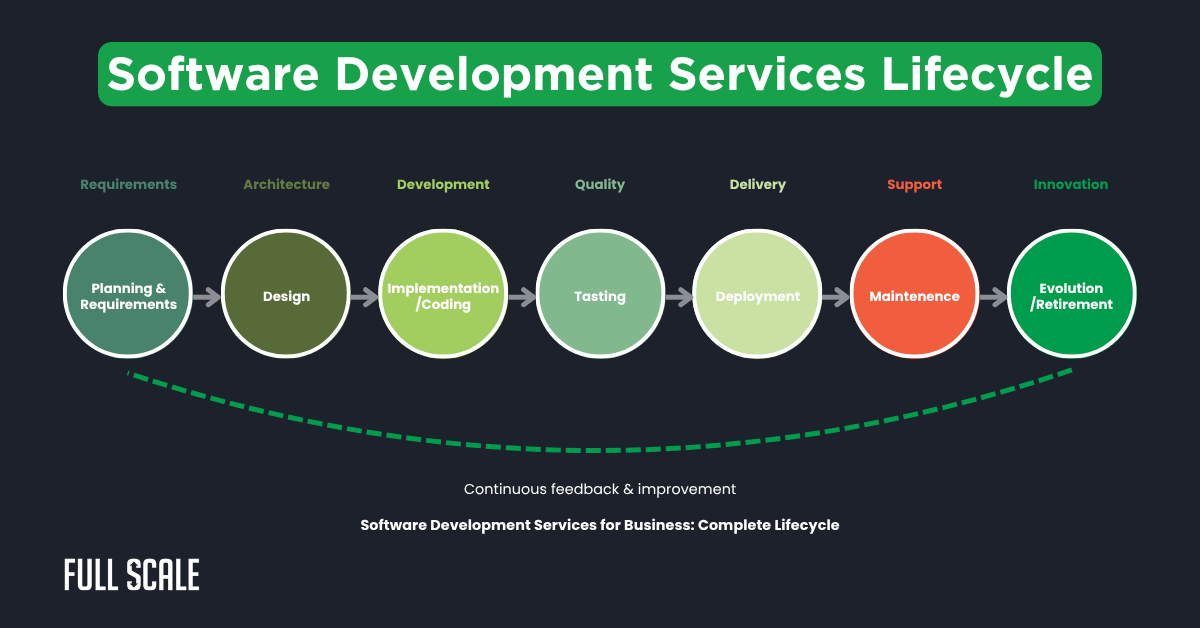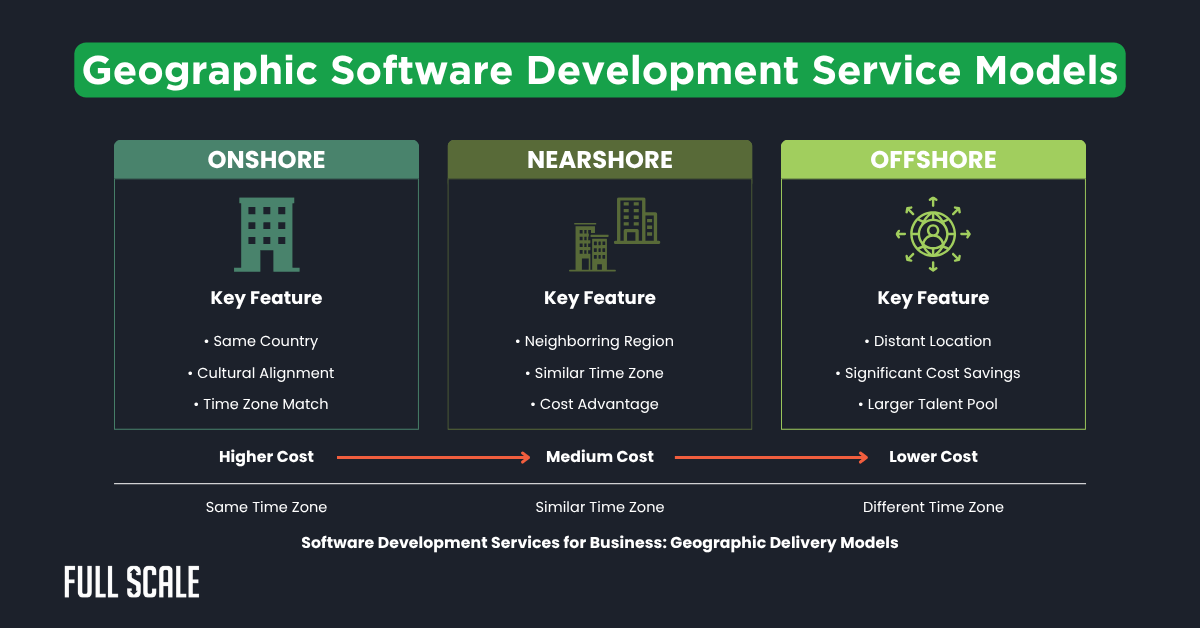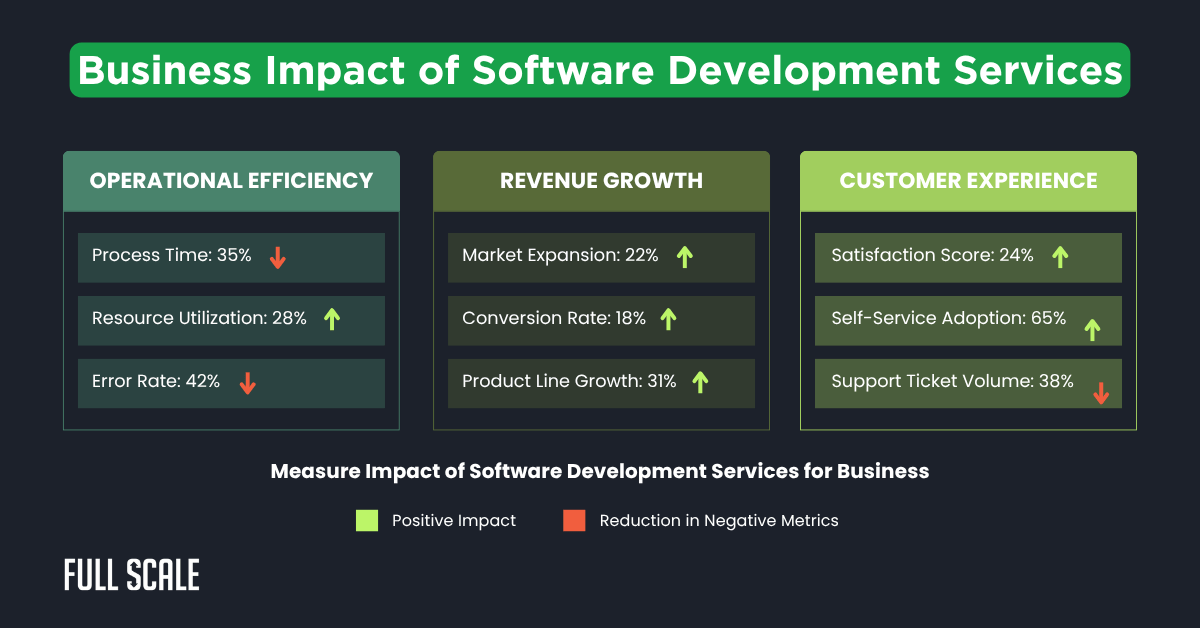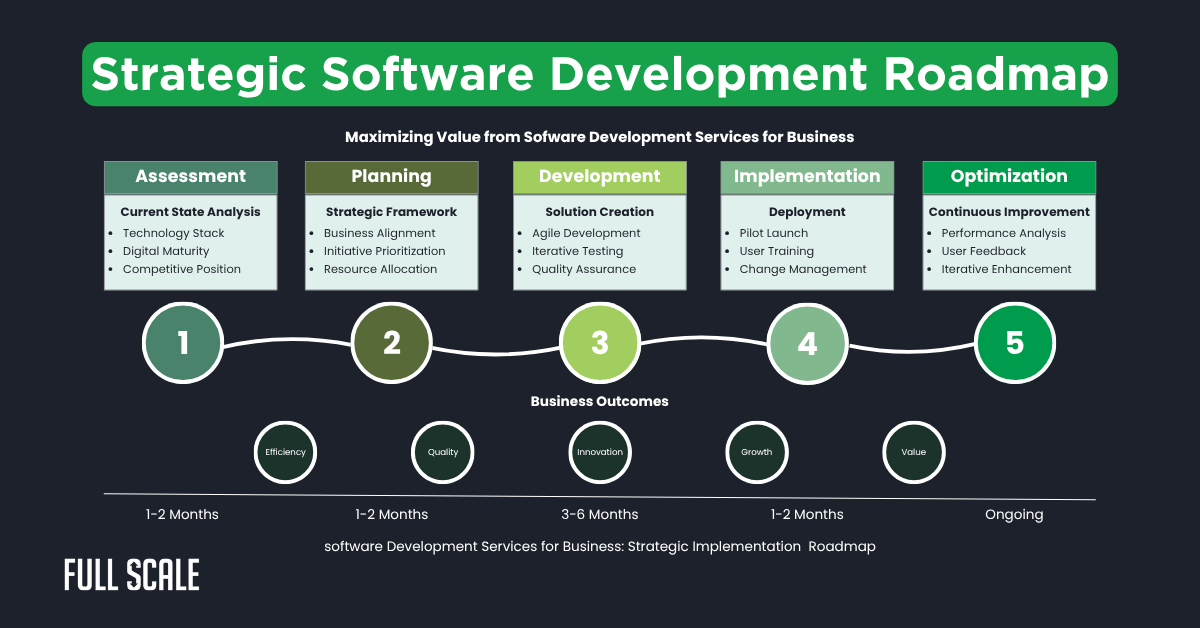Software development services for business have become essential for organizational growth and competitive advantage across industries worldwide. Companies of all sizes leverage these services to streamline operations, enhance customer experiences, and drive innovation.
According to recent industry reports, businesses that effectively implement custom software solutions experience a 31% increase in operational efficiency and a 27% reduction in overhead costs.
This comprehensive guide addresses the critical considerations for technical leaders, product managers, financial decision-makers, and HR professionals evaluating software development services.
What Are Software Development Services?
Software development services for business encompass professional offerings that design, build, implement, and maintain software solutions tailored to specific organizational needs.
These services transform business requirements into functional applications that solve particular challenges or create new opportunities.
These specialized services differ significantly from general IT services:
- IT services focus on maintaining existing infrastructure and systems
- Software development services create new digital assets that generate lasting business value
- Strategic impact comes from building a technology portfolio rather than simply supporting operations
Software development services range from building enterprise resource planning systems to developing customer-facing mobile applications. Each solution addresses specific business challenges while creating unique competitive advantages.

The software development services lifecycle, from concept to deployment.
The 7 Stages of Software Development
Every successful software development initiative follows a structured process. Understanding these stages helps business leaders effectively participate in and guide development projects.
The software development lifecycle consists of seven essential stages that transform ideas into functional solutions:
- Planning and Requirements Analysis – Establishing the project’s foundation through stakeholder interviews and business analysis
- System Design – Transforming requirements into detailed technical specifications through architecture planning and UX design
- Implementation/Coding – Converting designs into functional code using appropriate programming languages and frameworks
- Testing – Verifying that the software meets requirements through systematic testing methods
- Deployment – Moving completed software to production environments where end users can access it
- Maintenance – Providing ongoing support to address issues, implement updates, and ensure alignment with business needs
- Evolution/Retirement – Continuously evolving software through enhancements or eventually retiring obsolete systems
Business leaders should understand their role in each stage to ensure project success and alignment with organizational goals.
4 Types of Software Development Services for Business Needs
Software development services for business come in various forms, each addressing specific organizational requirements. Understanding these distinctions helps leaders select the right approach for their particular situation.
1. Custom Software Development Services
Custom software development creates tailored applications designed specifically for unique business requirements. These solutions address particular organizational challenges that off-the-shelf products cannot adequately solve.
Benefits of custom development include:
- Complete alignment with specific business processes and workflows
- Full control over features, integrations, and future enhancements
- Elimination of licensing fees and potential competitive advantage
- Proprietary functionality that competitors cannot easily duplicate
The table below compares custom software with off-the-shelf solutions:
| Factor | Custom Software | Off-the-Shelf Software |
| Initial Cost | Higher upfront investment | Lower initial purchase price |
| Ongoing Costs | Maintenance and enhancements only | Annual licensing fees plus customization |
| Timeline | 3-12+ months depending on complexity | Immediate to weeks for implementation |
| Business Fit | Perfect alignment with requirements | Compromise between features and needs |
| Competitive Advantage | Potential unique market differentiation | Same capabilities available to competitors |
| Flexibility | Complete control over future changes | Limited to vendor’s development roadmap |
2. Enterprise Software Development Services
Enterprise software development services create large-scale applications that support complex organizational operations. These comprehensive solutions integrate across multiple departments and business functions.
Key components of enterprise software development include:
- Complex business logic implementation across organizational units
- Integration with legacy systems and existing infrastructure
- Role-based access control and sophisticated security models
- Advanced reporting and analytics capabilities
- High-volume data processing and transaction management

Enterprise software development services integrate complex business systems for maximum operational efficiency
3. Software Product Development Services
Software product development services create market-ready applications intended for commercial distribution. This approach focuses on creating solutions that address market needs rather than internal business requirements.
The product development process follows these key phases:
| Phase | Activities | Business Involvement |
| Discovery | Market research, competitor analysis, value proposition definition | Executive input on market strategy and positioning |
| Conceptualization | Feature prioritization, user journey mapping, technical feasibility | Product management guidance on target audience needs |
| MVP Development | Core functionality implementation, basic UX/UI | Funding decisions, resource allocation |
| Market Testing | Limited release, user feedback collection, analytics | Marketing strategy, customer acquisition planning |
| Iteration | Feature enhancement, performance optimization | Pricing strategy, go-to-market planning |
| Scaling | Infrastructure expansion, support system development | Sales channel development, partnership strategy |
4. Specialized Development Services
Specialized development services focus on specific industries or technical domains that require unique expertise. These services provide targeted solutions for particular business sectors.
Popular specialized development services include:
- Fintech Software Development Services – Payment processing, investment platforms, banking interfaces with robust security measures, and regulatory compliance
- Healthcare Software Development – Patient portals, telemedicine platforms, clinical decision support systems compliant with regulations like HIPAA
- Retail and E-commerce Solutions – Inventory management, order processing systems, customer experience platforms with payment gateway integrations
Business Models for Software Development Services
Organizations can access software development services through various engagement models. The right approach depends on project requirements, internal capabilities, and strategic priorities.
Model 1: In-House vs. Outsourced Development
Organizations must decide whether to build internal development capabilities or partner with external providers. This fundamental choice impacts resource allocation, project timelines, and long-term technology strategy.
Key differences between these approaches include:
| Factor | In-House Development | Outsourced Development |
| Initial Investment | High (recruitment, training, infrastructure) | Low (project-based or retainer) |
| Time to Capability | 3-6+ months for team building | Immediate access to expertise |
| Cost Structure | Fixed costs regardless of project volume | Variable costs aligned with project needs |
| Quality Control | Direct oversight and alignment with culture | Depends on partner selection and management |
| Knowledge Retention | Complete retention of expertise and IP | Potential knowledge transfer challenges |
| Scalability | Limited by hiring capacity | Highly scalable based on project needs |
| Management Overhead | Significant HR and operational responsibilities | Reduced internal management requirements |
Many organizations implement hybrid models that combine internal teams with external partners for optimal results.
Model 2: Engagement Models
Software development partners offer various engagement structures to accommodate different project types and business needs. Each model provides distinct advantages for specific scenarios.
The most common engagement models include:
- Project-Based Development – Delivers complete projects with defined scope, timeline, and budget
- Dedicated Teams – Provides exclusive resources that function as an extension of the client’s organization
- Staff Augmentation – Integrates individual technical resources into existing client teams
- Technical Consultation – Provides expert guidance and oversight rather than direct development resources
Geographic Service Models
Software development services can be delivered from various geographic locations relative to the client organization. Each model offers different benefits regarding cost, communication, and cultural alignment.

Geographic software development service models balance cost, communication, and expertise.
The table below compares these geographic models:
| Factor | Onshore | Nearshore | Offshore |
| Cost Efficiency | Lowest (typically 100% of baseline) | Medium (typically 70-85% of onshore) | Highest (typically 40-60% of onshore) |
| Time Zone Overlap | Complete (8+ hours) | Substantial (4-6 hours) | Limited (0-3 hours) |
| Communication Ease | Highest (shared language and culture) | Medium (some cultural differences) | Most challenging (significant cultural differences) |
| Travel Requirements | Minimal (same-day visits possible) | Moderate (short international trips) | Significant (long-haul international travel) |
| Talent Pool Size | Limited to local market | Moderate regional access | Access to global technology hubs |
Technology Stack Considerations
Selecting the right technologies is a critical decision in software development services for business. These choices impact development speed, system performance, and long-term maintainability.
Frontend Technologies
Front-end technologies create the user interfaces that people interact with directly. These components determine how users experience your software through visual design, interaction patterns, and response times.
Popular front-end frameworks include:
| Framework | Business Applications | Key Advantages |
| React | Single-page applications, complex interfaces | Component reusability, robust ecosystem |
| Angular | Enterprise applications, complex workflows | Comprehensive framework, TypeScript integration |
| Vue.js | Marketing sites, e-commerce, dashboards | Gentle learning curve, progressive adoption |
| Flutter | Cross-platform mobile applications | Single codebase for iOS/Android, performance |
Backend Development
Back-end technologies handle business logic, data processing, and system integrations. These components determine system scalability, performance, and security.
Key back-end technology considerations include:
- Server-Side Languages – Node.js, Java/Spring, C#/.NET, Python/Django, PHP/Laravel, Go
- Database Options – Relational (PostgreSQL, MySQL), Document (MongoDB), Key-Value (Redis), Graph (Neo4j)
- API Development – REST, GraphQL, gRPC for system integration and communication
- Security Implementation – Authentication, authorization, encryption, threat protection
Emerging Technologies in Business Applications
Emerging technologies create new possibilities for business innovation through advanced capabilities. Early adoption can create competitive advantages through capabilities unavailable to competitors.
Business applications of emerging technologies include:
- AI and Machine Learning – Customer service chatbots, predictive maintenance, fraud detection
- IoT Solutions – Supply chain visibility, manufacturing monitoring, smart building management
- Blockchain Applications – Supply chain traceability, smart contracts, secure transaction records
- Edge Computing – Real-time processing, reduced cloud costs, enhanced privacy protection
The Business Case for Software Development Services
Building a compelling business case requires a thorough analysis of costs, benefits, and risks. This structured approach helps secure executive support and funding approval for business software development services.
ROI Analysis Framework
Return on investment calculations justify software development expenditures through projected benefits. This analysis compares total costs against expected financial returns.
A comprehensive ROI model includes these components:
| Cost Components | Description | Calculation Approach |
| Initial Development | Design, programming, testing, deployment | Vendor quotes or internal estimates based on effort |
| Hardware/Infrastructure | Servers, cloud services, networking | Current market rates with capacity planning |
| Licenses | Third-party software, frameworks, services | Published pricing with volume discounts |
| Training | User and administrator education | Hours × rates + materials + productivity impact |
| Integration | Connecting with existing systems | Complexity assessment with specialist estimates |
| Maintenance | Ongoing support, updates, bug fixes | Annual % of initial development (typically 15-20%) |
| Benefit Components | Description | Calculation Approach |
| Labor Savings | Reduced manual effort, headcount avoidance | Hours saved × fully loaded employee cost |
| Revenue Increase | Additional sales, new products/services | Volume increase × profit margin |
| Cost Reduction | Lower operational expenses, error reduction | Direct savings + reduced correction costs |
| Time Savings | Faster processes, reduced cycle times | Process time reduction × transaction volume × value |
| Quality Improvement | Fewer defects, higher customer satisfaction | Reduced failures × cost per failure |
Business Impact Metrics
Beyond financial calculations, business impact metrics demonstrate how software development affects organizational capabilities. These measures connect technology investments to strategic objectives.

Software development services for business drive measurable impact across key performance indicators.
Key business impact categories include:
- Operational Efficiency Gains – Process cycle time reduction, resource utilization improvement, error rate decrease
- Revenue Growth Opportunities – New market entry, product line extension, conversion rate improvement
- Customer Experience Improvements – Satisfaction score enhancement, self-service adoption increase, support ticket volume reduction
Risk Mitigation Strategies
Software development inherently involves uncertainty that must be proactively managed. Effective risk management includes:
| Risk Category | Description | Mitigation Strategies |
| Technical Risk | Technology failures, integration challenges | Proof-of-concepts, architecture reviews, performance testing |
| Market Risk | Changing requirements, competitor actions | Agile methodologies, competitor monitoring, compliance experts |
| Resource Risk | Skill shortages, knowledge gaps | Cross-training, documentation requirements, resource redundancy |
| Timeline Risk | Delays, unrealistic estimates | Buffer planning, clear change procedures, milestone tracking |
| Budget Risk | Cost overruns, unexpected expenses | Contingency reserves, phased approaches, regular financial reviews |
Selecting the Right Software Development Partner
Choosing the right development partner significantly impacts project success. This decision requires a systematic evaluation of potential providers against established criteria.
Evaluation Criteria
A comprehensive evaluation requires assessment across multiple dimensions. These criteria help compare potential partners objectively for software development services for business.
Key evaluation areas include:
- Technical Expertise Assessment – Verify skills in specific technologies relevant to your project through certifications, code samples, and technical challenge exercises
- Industry Experience Verification – Confirm domain knowledge in your business sector through case studies, client references, and compliance demonstrations
- Project Management Methodology – Examine how partners structure development activities using defined SDLC approaches, tracking systems, and communication protocols
Due Diligence Process
Thorough due diligence verifies vendor claims and identifies potential concerns. This investigative process examines both capabilities and business stability.
Due diligence activities include:
- Portfolio and Case Study Analysis – Examine the scope, complexity, challenges, outcomes, and technologies of previous projects
- Client Reference Checks – Verify claims about capabilities through conversations with current and former clients
- Code Quality Assessment – Review code samples for structure, documentation, maintainability, and security practices
Red Flags to Watch For
Certain warning signs indicate potential problems with development partners. These red flags warrant additional investigation before proceeding.
Common warning signs include:
- Unrealistic Promises – Dramatically lower cost estimates, timeline estimates below industry norms, guaranteed results without contingencies
- Lack of Transparency – Reluctance to explain methodologies, vague process descriptions, limited access to technical team members
- Poor Communication – Delayed responses, unclear explanations, inability to translate technical concepts into business terms
Managing Software Development Projects Successfully
Effective project management ensures software development initiatives deliver expected business value. These practices maintain alignment between technical execution and business objectives.
Requirements Gathering and Documentation
Comprehensive requirements form the foundation for successful development projects. These specifications translate business needs into actionable technical guidance.
Requirements development follows this progressive elaboration:
| Level | Description | Business Involvement | Format |
| Business Requirements | High-level organizational needs and objectives | Executive input and approval | Vision documents, business case |
| User Requirements | Capabilities needed by specific user groups | Stakeholder interviews and validation | User stories, use cases |
| Functional Requirements | Detailed system behaviors and features | Subject matter expert input and verification | Feature specifications, acceptance criteria |
| Non-Functional Requirements | Performance, security, compliance needs | Compliance, security, and operations teams | Technical specifications, constraints |
Effective Project Management Approaches
Modern software development services for business utilize various methodologies depending on project characteristics. The right approach depends on requirement clarity, change frequency, and stakeholder involvement.
Popular project management approaches include:
- Agile Methodologies – Incremental delivery through short development cycles requiring regular business input and feedback
- Scrum Implementation – Structured framework with defined roles and ceremonies that work well for evolving requirements
- Kanban Workflow – Visualizes work through stages on a board, focusing on workflow optimization and constraint management
Quality Assurance for Business-Critical Applications
Quality assurance ensures software meets business requirements through systematic testing. These practices verify functionality, performance, security, and compliance.
The testing strategy should include:
| Testing Type | Purpose | Business Involvement |
| Functional Testing | Ensure the system handles the expected load | Validate business fitness for the purpose |
| Performance Testing | Provide acceptance criteria and validate test scenarios | Define performance requirements, identify peak scenarios |
| Security Testing | Protect data and prevent unauthorized access | Specify data sensitivity, compliance requirements |
| Verify that features work as specified | Perform hands-on testing, and provide approval | Perform hands-on testing, provide approval |
| Regression Testing | Ensure changes don’t break existing functionality | Identify critical business processes for coverage |
Team Building and Management
Software development requires effective teams with the right skills and a working environment. Team composition significantly impacts project success through capability alignment and collaboration effectiveness.
Skill Set Requirements
Successful projects require appropriate technical and soft skills. Comprehensive skill planning ensures teams can handle project requirements.
Essential technical roles include:
| Role | Responsibilities | Key Skills |
| Software Architect | System design, technical standards, scalability planning | Architecture patterns, performance optimization, security by design |
| Backend Developer | Server-side logic, database interaction, API development | Programming languages, database design, API protocols |
| Frontend Developer | User interface implementation, client-side logic | HTML/CSS, JavaScript frameworks, responsive design |
| DevOps Engineer | Deployment automation, infrastructure management | CI/CD pipelines, cloud platforms, containerization |
| QA Engineer | Test planning, automation development, defect reporting | Test methodologies, automation tools, defect management |
Critical soft skills for software development services include:
- Clear communication across technical and non-technical audiences
- Collaboration within teams and across organizational boundaries
- Critical thinking and problem-solving beyond technical domains
- Time management and personal organization
- Adaptability to changing requirements and technologies
Team Integration Strategies
Effective integration creates cohesive teams that deliver consistent results. These strategies align new members with existing processes and culture.
Integration considerations include:
- Onboarding Best Practices – Technical environment setup, architecture overviews, documentation access, defined first tasks
- Knowledge Transfer Protocols – Documentation requirements, pair programming, code walkthroughs, knowledge base maintenance
- Communication Frameworks – Daily standups, weekly team sessions, documentation standards, escalation paths
Talent Retention in Software Development
Maintaining team stability requires attention to retention factors beyond compensation. Development professionals value growth opportunities and meaningful work.
Key retention elements include:
- Career Development Paths – Technical and leadership tracks, skill assessment, learning resources, certification support
- Recognition and Reward Systems – Technical achievement awards, peer recognition programs, project milestone celebrations
- Team Engagement Strategies – Interesting project assignments, innovation time, and continuous learning opportunities
Real-World Success Stories
Examining successful implementations provides valuable insights into effective approaches. These case studies demonstrate practical applications of software development services for business.
Enterprise Digital Transformation
Challenge: A mid-sized manufacturing company struggled with outdated systems causing production delays and customer service issues. Legacy applications couldn’t integrate with modern systems or support mobile access.
Approach: The company partnered with Full Scale to develop a comprehensive digital transformation strategy. The approach combined custom development with strategic system integration.
Solution: Full Scale delivered an integrated enterprise system with centralized ERP, mobile applications, customer portal, API layer, and business intelligence dashboards.
Results:
- 37% reduction in order processing time
- 23% decrease in inventory carrying costs
- 42% improvement in on-time delivery performance
- $1.2M annual savings from process automation
- 98% customer satisfaction rating through improved visibility

Software development services for business drive measurable transformation outcomes.
Product Development Case Study
Challenge: A financial services startup identified a market opportunity for simplified investment management targeting younger demographics. Limited internal technical resources necessitated external development support.
Approach: The startup engaged Full Scale to provide end-to-end product development services utilizing lean startup methodologies focused on rapid MVP creation.
Solution: Full Scale delivered a comprehensive investment platform with a mobile-first design, automated portfolio creation, bank account integration, and robust security.
Results:
- $5.3M in assets under management within six months
- 28,000 active users exceeding first-year projections
- 4.7/5 average rating in app stores
- Featured in three major financial publications
- Successful Series A funding round based on early traction
Operational Efficiency Improvement
Challenge: A healthcare provider struggled with inefficient patient management processes, causing long wait times and staff frustration. Paper-based workflows created documentation errors and compliance risks.
Approach: The organization partnered with Full Scale to analyze current workflows and implement digital solutions prioritizing user experience for both staff and patients.
Solution: Full Scale delivered an integrated patient management system with digital check-in, automated appointment reminders, resource scheduling optimization, and EHR integration.
Results:
- 68% reduction in patient check-in time
- 42% decrease in scheduling errors
- 27% improvement in resource utilization
- 35% reduction in administrative staff workload
- 31% increase in patient satisfaction scores
Future Trends in Software Development Services
Understanding emerging trends helps organizations prepare for technological evolution. These advancements will reshape how businesses create and utilize software development services for business.
AI-Powered Development
Artificial intelligence increasingly transforms the software development process itself. These technologies automate routine tasks and enhance developer capabilities.
Key developments include:
- Low-Code/No-Code Platforms – Visual development environments enabling business users to create applications with minimal coding
- AI-Assisted Programming – Intelligent tools augmenting developer capabilities through code suggestions and automated testing
- Automated Testing and QA – AI-driven test generation and execution improve software quality while reducing manual effort
- Predictive Maintenance – Systems that anticipate failures before they occur based on pattern recognition
Next-Generation Delivery Models
Development methodologies continue evolving toward greater automation and integration. These approaches break down silos between development and operations.
Key developments include:
- DevOps Evolution – Mature practices with complete automation, observability, and security integration
- Continuous Everything – Seamless pipelines for integration, delivery, deployment, and improvement
- Platform Engineering – Self-service infrastructure accelerating development through standardization
- Value Stream Delivery – End-to-end optimization focusing on business value flow rather than technical activities
Emerging Business Applications
New technologies enable entirely new business capabilities and models. Early adoption can establish market leadership in emerging categories.
Key developments include:
- Quantum Computing Readiness – Preparing algorithms and security for unprecedented processing capabilities
- Edge Computing Solutions – Distributed processing moves computation closer to data sources for reduced latency
- Decentralized Applications – Blockchain-based systems removing central authorities while ensuring data integrity
- Extended Reality in Business – AR/VR applications for training, design, and remote collaboration
Getting Started: Your Software Development Roadmap
Creating a structured approach helps organizations maximize value from software development services for business. This roadmap provides a framework for assessment, planning, and implementation.

Strategic roadmap for implementing successful software development services for business.
Current State Assessment
Thorough evaluation of existing systems and capabilities establishes the foundation for improvement. This assessment identifies strengths, weaknesses, and opportunities.
Assessment areas include:
- Digital Maturity Evaluation – Technology infrastructure flexibility, data accessibility, automation level, digital channel effectiveness
- Technology Stack Analysis – Application inventory, technical debt assessment, scalability evaluation, security posture review
- Competitive Positioning Assessment – Competitor capability benchmarking, customer experience comparison, digital channel effectiveness
Strategic Planning Framework
Structured planning aligns technology initiatives with business objectives. This framework establishes priorities and resource allocation.
Planning components include:
- Business Goal Alignment – Connecting technology initiatives to specific strategic objectives with documented value contributions
- Initiative Prioritization – Systematic evaluation determining optimal sequence based on business impact and resource constraints
- Resource Allocation Guidance – Balancing internal capabilities with external partnerships for optimal results
Implementation Path
Structured execution converts plans into business value through effective delivery. This framework establishes how initiatives move from concept to reality.
Implementation elements include:
- Pilot Project Selection – Initial projects demonstrating value while building organizational capability
- Team Assembly – Appropriate resources ensuring successful delivery through skill alignment
- Success Measurement – Comprehensive metrics tracking progress and validating business impact
Full Scale Software Development Services
Full Scale specializes in providing comprehensive software development services for businesses across various industries and technical domains. Our expertise helps organizations accelerate their digital initiatives while maintaining quality and controlling costs.
Our Software Development Services
We offer a complete range of software development services designed to meet diverse business needs:
- Custom Software Development – Tailored solutions addressing specific business challenges with proprietary functionality
- Enterprise Application Development – Large-scale systems supporting complex organizational operations and workflows
- Product Development – Market-ready applications from concept to commercialization with MVP approaches
- Mobile Application Development – Native and cross-platform solutions for iOS and Android devices
- Web Application Development – Responsive, browser-based applications with modern frameworks and APIs
- Quality Assurance and Testing – Comprehensive verification ensuring functionality, performance, and security
- DevOps Implementation – Continuous integration/delivery pipelines accelerating release cycles
Key Takeaways: Maximizing Value from Software Development Services
Software development services for business represent a strategic investment in organizational capabilities and competitive advantage. These services transform business requirements into technical solutions that drive measurable outcomes.
Essential Considerations for Business Leaders
When implementing software development services for your organization, keep these key points in mind:
- Strategic Alignment – Connect development initiatives directly to business objectives and measure their impact on key performance indicators
- Solution Selection – Choose the right type of software development service based on your specific needs, considering both immediate requirements and long-term strategy
- Engagement Model – Select appropriate business models balancing control, cost, flexibility, and expertise for your organization’s specific context
- Technology Decisions – Make informed technology choices considering not just current capabilities but future flexibility and maintenance requirements
- Partner Selection – Evaluate potential development partners thoroughly against objective criteria with proper due diligence
- Project Management – Implement effective management practices, maintaining alignment between technical execution and business objectives
- Team Building – Assemble cross-functional teams with both technical expertise and business domain knowledge
Accelerate Your Digital Transformation with Full Scale
Implementing effective software development services is critical for businesses seeking a competitive advantage in today’s digital landscape.
At Full Scale, we specialize in helping organizations like yours build and manage high-performing development teams equipped with the expertise to deliver custom software solutions that drive measurable business outcomes.
Why Choose Full Scale?
- Technical Excellence: Our development teams bring deep expertise across front-end, back-end, and specialized technologies.
- Flexible Engagement Models: Choose from dedicated teams, project-based development, or staff augmentation to match your specific needs.
- Industry Experience: Leverage our domain knowledge in fintech, healthcare, retail, and enterprise solutions.
- Proven Delivery Process: Our structured methodology ensures reliable outcomes from requirements to deployment.
- Strategic Partnership: We align technology decisions with your business goals for maximum ROI.
Don’t let technical limitations constrain your business potential. Schedule a free consultation today to learn how Full Scale can accelerate your software development initiatives.
Hire Full Scale Developers Today
FAQs: Software Development Services for Business
What is a software development service?
Software development services for business are professional offerings that design, build, implement, and maintain custom software solutions tailored to specific organizational needs. These services transform business requirements into functional applications that solve particular challenges or create new opportunities.
Key components include:
- Requirements gathering and analysis
- System architecture and design
- Programming and implementation
- Testing and quality assurance
- Deployment and maintenance
- Ongoing support and evolution
What are the 7 stages of software development?
The seven stages of software development include:
- Planning and Requirements Analysis – Establishing the project’s foundation through stakeholder interviews
- System Design – Creating technical specifications through architecture planning
- Implementation/Coding – Converting designs into functional code
- Testing – Verifying that the software meets requirements through systematic testing
- Deployment – Moving completed software to production environments
- Maintenance – Providing ongoing support and updates
- Evolution/Retirement – Continuously enhancing or eventually retiring systems
Does software development pay good?
Software development offers competitive compensation due to high market demand and specialized skills. According to industry data, software developers earn 18-32% above national salary averages across most markets.
Factors affecting compensation include:
- Experience level and specialized expertise
- Industry sector (fintech typically pays the highest)
- Geographic location and market demand
- Company size and type (enterprise vs. startup)
- Full-time employment vs. contracting rates
What is the difference between IT services and software services?
IT services and software development services for business have distinct focuses and outcomes:
IT Services:
- Focus on maintaining existing infrastructure and systems
- Typically operational expenditure (OpEx)
- Support day-to-day business operations
- Include helpdesk support, network management, and system administration
- Reactive maintenance and troubleshooting
Software Development Services:
- Create new custom applications that address particular business needs
- Often, capital investment (CapEx) in new capabilities
- Build digital assets that create competitive advantages
- Include design, coding, testing, and deployment
- Proactive creation of business solutions
How do I choose between custom and off-the-shelf software?
When choosing between custom and off-the-shelf software development services for business, consider:
- Business Process Uniqueness – Custom development better addresses unique processes and workflows
- Competitive Differentiation – Custom solutions can create unique market advantages
- Integration Requirements – Complex integration needs may favor custom development
- Time Constraints – Off-the-shelf deploys faster initially, but may require customization
- Budget Structure – Off-the-shelf has lower upfront cost,s but ongoing licensing fees
- Control Requirements – Custom development provides complete control over features anthe d roadmap
What are the most important factors when selecting a development partner?
Critical factors for selecting a software development services partner include:
- Technical expertise aligned with your specific project requirements
- Industry experience relevant to your business context
- Project management methodologies compatible with your organization
- Communication practices ensuring transparency and responsiveness
- Quality assurance processes deliver reliable solutions
- Cultural compatibility with your team
- Financial stability for long-term support
- Verifiable references from similar organizations
How long does custom software development typically take?
Custom software development timelines vary based on project scope, complexity, and methodology:
- Simple applications with limited functionality: 2-4 months
- Medium-complexity business applications: 4-8 months
- Enterprise-level systems with extensive integration: 8-18+ months
Agile approaches deliver initial functionality faster through incremental releases. Software development services for business typically include detailed timeline estimates during initial planning phases.
What should be included in a software development contract?
A comprehensive software development services contract should include:
- Detailed scope of work with deliverables and acceptance criteria
- Timeline with specific milestones and dependencies
- Pricing structure and payment terms
- Intellectual property ownership clarification
- Change management procedures
- Testing and quality requirements
- Warranty provisions
- Support and maintenance terms
- Confidentiality and data protection obligations
- Termination conditions
- Dispute resolution procedures

Matt Watson is a serial tech entrepreneur who has started four companies and had a nine-figure exit. He was the founder and CTO of VinSolutions, the #1 CRM software used in today’s automotive industry. He has over twenty years of experience working as a tech CTO and building cutting-edge SaaS solutions.
As the CEO of Full Scale, he has helped over 100 tech companies build their software services and development teams. Full Scale specializes in helping tech companies grow by augmenting their in-house teams with software development talent from the Philippines.
Matt hosts Startup Hustle, a top podcast about entrepreneurship with over 6 million downloads. He has a wealth of knowledge about startups and business from his personal experience and from interviewing hundreds of other entrepreneurs.




